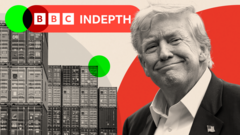President Donald Trump’s recent enactment of sweeping new import tariffs has captured global attention, drawing both optimism and skepticism about the potential outcomes. Initially announced in April, Trump's tariff policies were met with a financial panic that led him to suspend many of the proposed measures. However, four months later, the President is celebrating what he describes as victories, having negotiated numerous agreements with trading partners and imposed tariffs on others, all while maintaining a relatively stable financial marketplace.
The future benefits of these measures, including hopes for increased government revenue, boosted domestic manufacturing, and foreign investments, remain uncertain. The shift toward protectionism has escalated significantly, with the once-gentle tide toward free trade now crashing across various global economies. Opponents warn that the long-term implications of Trump's tariffs could yield unexpectedly adverse outcomes, potentially reshaping global alliances.
International policymakers have been keenly aware of the August 1 deadline set by Trump for concluding trade agreements, which hinted at significant tariff implications for non-compliance. By the end of July, Trump had announced merely a few agreements, leading many to question the deepness and longevity of these arrangements. Countries like the UK have established deals with a relatively moderate 10% tariff rate, while others, such as the EU and Japan, face heftier tariffs starting at 15% due to more substantial trade deficits with the U.S.
While some nations may suffer from the financial fallout of these tariffs, the overall economic impact may be less severe than originally feared, and businesses are now better positioned to adapt and forecast their plans. Yet, despite raising much-needed revenue exceeding $100 billion this year for the federal government, these tariffs also contribute to noticeably increased consumer prices, potentially undermining Trump's political support.
The political implications of Trump's trade policies are troubling, especially as he faces upcoming midterm elections. Many Americans may bear the brunt of higher prices for consumer goods, which may not align with the president's promises to lower costs. While some limited aid solutions, like providing rebates to low-income individuals, have been floated, these would require congressional approval and could prove cumbersome.
Furthermore, many trade negotiations remain incomplete, with crucial nations like Canada and Taiwan still harboring unsettled agreements. Trump's overarching strategy of bringing production and jobs back to America could face significant hurdles as foreign partners redirect their economic alliances in response to U.S. policies.
As the global landscape shifts in reaction to these tariffs, time will tell whether Trump’s assertive trade strategies will yield the anticipated domestic manufacturing surge and improved economic positioning or plunge the U.S. into a more precarious international trading environment. The answers to these pressing questions will unfold over the coming years, with American consumers potentially facing higher living costs and diminished choices in the interim.





















